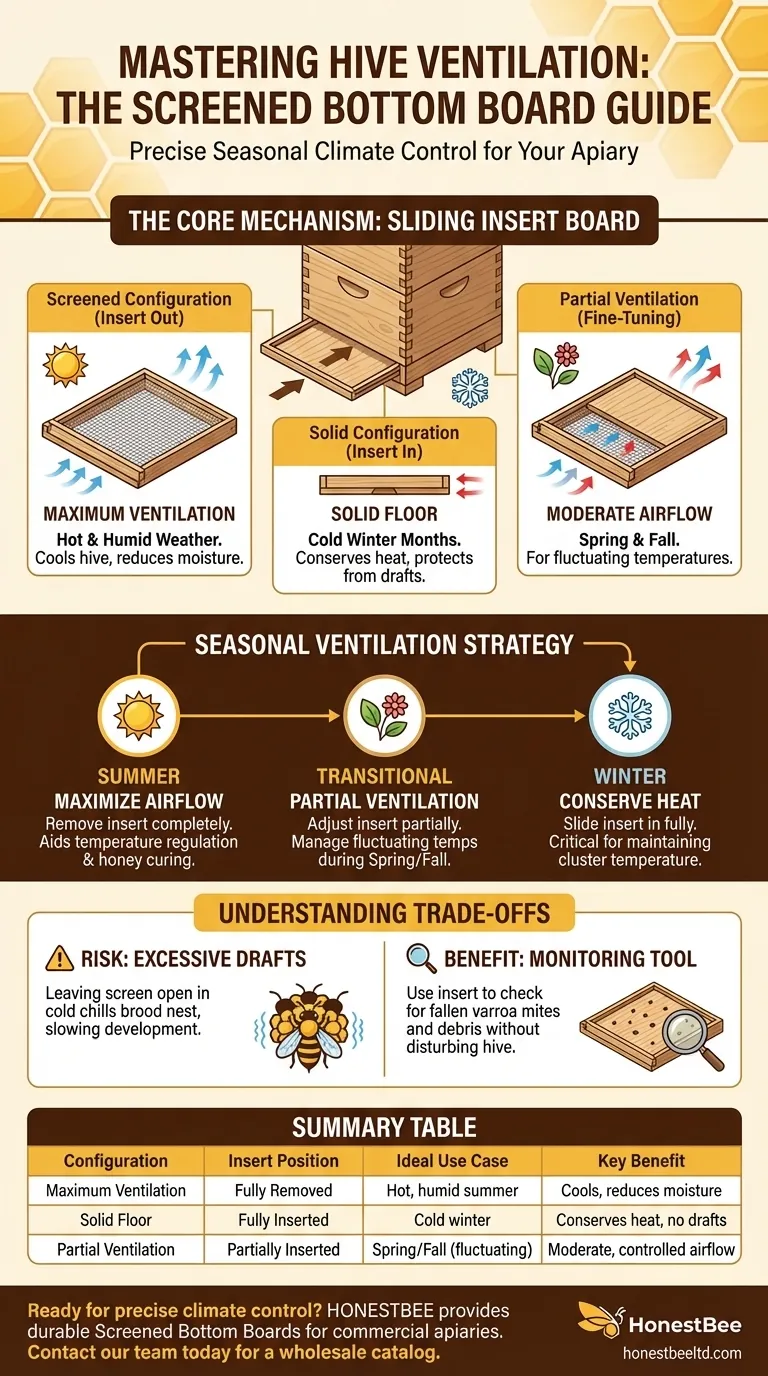To adjust hive ventilation using a Screened Bottom Board, you use the sliding insert board. Sliding the board in creates a solid, insulated floor that reduces airflow, while sliding it out reveals a screen that maximizes ventilation. This simple mechanism allows you to precisely manage the hive's internal climate throughout the year.
The Screened Bottom Board is not just a vent; it's a seasonal climate control system for your hive. Mastering the sliding insert allows you to actively manage temperature and moisture, directly impacting your colony's health and productivity.

The Core Mechanism: The Sliding Insert Board
The versatility of the Screened Bottom Board comes from its 3-in-1 design, which is controlled by a single, removable component.
The Screened Configuration (Insert Out)
When the insert is fully removed, the bottom of the hive is an open screen. This provides the maximum possible ventilation.
This configuration is ideal for hot and humid weather, as it helps the colony cool the hive and reduce internal moisture buildup.
The Solid Configuration (Insert In)
Sliding the insert all the way in effectively creates a solid bottom board. This significantly reduces airflow and helps retain heat.
This is the standard and recommended configuration for cold winter months, as it protects the colony from chilling drafts.
Partial Ventilation for Fine-Tuning
You can also slide the insert in partially, leaving a portion of the screen exposed. This allows for a moderate, controlled level of ventilation.
This technique is most useful during the transitional seasons of spring and fall when temperatures can fluctuate dramatically.
Seasonal Ventilation Strategy
Properly using the insert board is key to supporting your colony's needs as the seasons change. Your goal is to help them manage their environment with minimal stress.
Summer: Maximizing Airflow
During the hottest months, remove the insert board completely. This allows for optimal air circulation through the hive.
This ventilation helps the bees regulate internal temperature and dehydrate nectar into honey more efficiently, reducing their workload.
Winter: Conserving Heat
Before cold weather sets in, slide the insert board in to create a solid floor. This is critical for helping the colony maintain its winter cluster temperature.
A solid floor minimizes cold drafts that can stress the bees and force them to consume more of their vital honey stores.
Understanding the Trade-offs
While highly effective, the Screened Bottom Board requires active management to avoid potential issues.
Risk of Excessive Drafts
Leaving the screen fully open in cool or cold weather can be detrimental. A constant draft can chill the brood nest, stressing the colony and slowing its development.
The Insert as a Monitoring Tool
The sliding insert serves a valuable dual purpose. After leaving it in for a period, you can remove it to check for fallen varroa mites or other hive debris.
This provides valuable insight into the colony's health and pest levels without having to open and disturb the hive.
Making the Right Choice for Your Season
Your use of the insert board should be dictated by the immediate needs of your colony and the external weather conditions.
- If your primary focus is reducing summer heat and humidity: Remove the insert board completely for maximum airflow.
- If your primary focus is protecting the colony during winter: Slide the insert board in fully to create a solid, draft-free floor.
- If your primary focus is monitoring for varroa mites: Insert the board for a 24-48 hour period, then remove and inspect it for fallen mites.
By actively managing your Screened Bottom Board, you gain precise and powerful control over your hive's internal environment.
Summary Table:
| Configuration | Insert Position | Ideal Use Case | Key Benefit |
|---|---|---|---|
| Maximum Ventilation | Fully Removed | Hot, humid summer weather | Cools hive, reduces moisture, aids honey curing |
| Solid Floor | Fully Inserted | Cold winter months | Conserves heat, protects from chilling drafts |
| Partial Ventilation | Partially Inserted | Spring/Fall (fluctuating temps) | Provides moderate, controlled airflow |
Ready to give your apiary the advantage of precise climate control?
As a trusted wholesale supplier for commercial apiaries and distributors, HONESTBEE provides durable, well-designed Screened Bottom Boards that make seasonal hive management simple and effective. Our equipment helps you proactively support colony health and maximize productivity.
Contact our team today to discuss your beekeeping supply needs and request a wholesale catalog.
Visual Guide

Related Products
- Langstroth Screen Bottom Board for Beekeeping Wholesale
- Australian Pine Wood Langstroth Screen Bottom Board for Wholesale
- HONESTBEE Wooden Bee Escape Board with Triangle Mesh Design for Beekeeping
- Multi-Functional Sliding Hive Entrance for Beekeeping
- HONESTBEE Multi Exit Plastic Bee Escape Board for Efficient Honey Harvesting
People Also Ask
- What are the assembly options for the Cypress Screened Bottom Board? Ready-to-Use for Immediate Hive Health
- How should the screened bottom board be used throughout the year? A Guide for Healthy Hives
- What are the benefits of a screened bottom board? Boost Hive Health & Control Varroa Mites
- What is the primary function of a screened bottom board in a hive? Enhance Ventilation & Control Varroa Mites
- What are some considerations when choosing between solid and screened bottom boards? Optimize Hive Health & Pest Control














